GIGABYTE Server GA-7PESH3 Motherboard Review
by Ian Cutress on September 4, 2014 2:00 PM EST- Posted in
- Motherboards
- Intel
- Gigabyte
- Xeon
- Workstation
- Enterprise
- C602
CPU Benchmarks
Readers of our motherboard review section will have noted the trend in modern motherboards to implement a form of MultiCore Enhancement / Acceleration / Turbo (read our report here) on their motherboards. This does several things, including better benchmark results at stock settings (not entirely needed if overclocking is an end-user goal) at the expense of heat and temperature. It also gives in essence an automatic overclock which may be against what the user wants. Our testing methodology is ‘out-of-the-box’, with the latest public BIOS installed and XMP enabled, and thus subject to the whims of this feature. It is ultimately up to the motherboard manufacturer to take this risk – and manufacturers taking risks in the setup is something they do on every product (think C-state settings, USB priority, DPC Latency / monitoring priority, memory subtimings at JEDEC). Processor speed change is part of that risk, and ultimately if no overclocking is planned, some motherboards will affect how fast that shiny new processor goes and can be an important factor in the system build.
Point Calculations – 3D Movement Algorithm Test: link
3DPM is a self-penned benchmark, taking basic 3D movement algorithms used in Brownian Motion simulations and testing them for speed. High floating point performance, MHz and IPC wins in the single thread version, whereas the multithread version has to handle the threads and loves more cores.
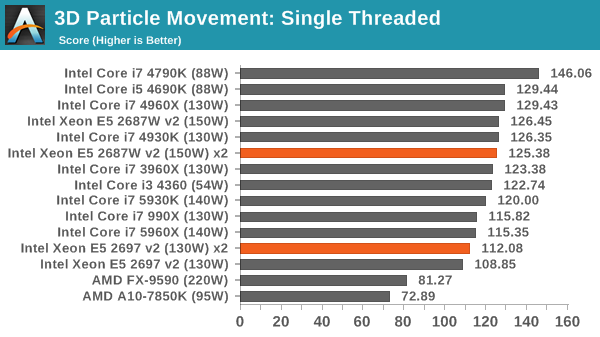
The single threaded test should be limited by the linear code, and we see in both dual CPU configurations it performs similarly to the single CPU result.
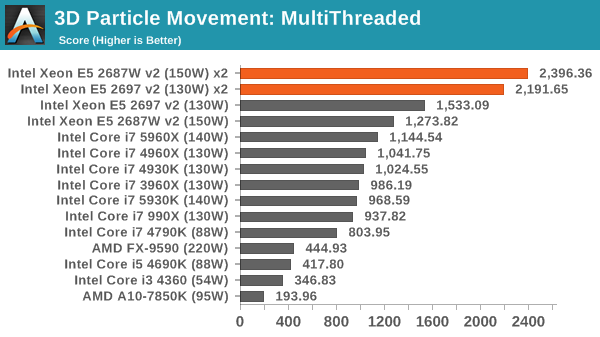
As the 3DPM algorithm involves no core-to-core data transfer, the 2P system can show its legs. Here the faster eight-core beats the slower 12-core.
Compression – WinRAR 5.0.1: link
Our WinRAR test from 2013 is updated to the latest version of WinRAR at the start of 2014. We compress a set of 2867 files across 320 folders totaling 1.52 GB in size – 95% of these files are small typical website files, and the rest (90% of the size) are small 30 second 720p videos.

WinRAR can take advantage of many threads in a system, however a 2P system presents some difficulty in managing that data. WinRAR also likes fast memory, and so as a result the single eight core 5960X can get a better result than any of our 2P configurations.
Image Manipulation – FastStone Image Viewer 4.9: link
Similarly to WinRAR, the FastStone test is updated for 2014 to the latest version. FastStone is the program I use to perform quick or bulk actions on images, such as resizing, adjusting for color and cropping. In our test we take a series of 170 images in various sizes and formats and convert them all into 640x480 .gif files, maintaining the aspect ratio. FastStone does not use multithreading for this test, and thus single threaded performance is often the winner.
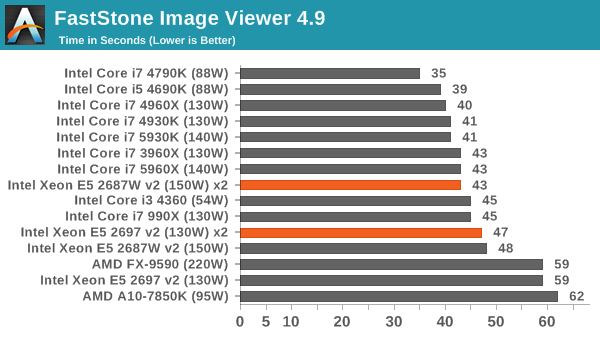
Video Conversion – Handbrake v0.9.9: link
Handbrake is a media conversion tool that was initially designed to help DVD ISOs and Video CDs into more common video formats. The principle today is still the same, primarily as an output for H.264 + AAC/MP3 audio within an MKV container. In our test we use two videos: a 640x266 2h20 film rip and a double UHD 10 minute animation short. Results are given in frames per second.
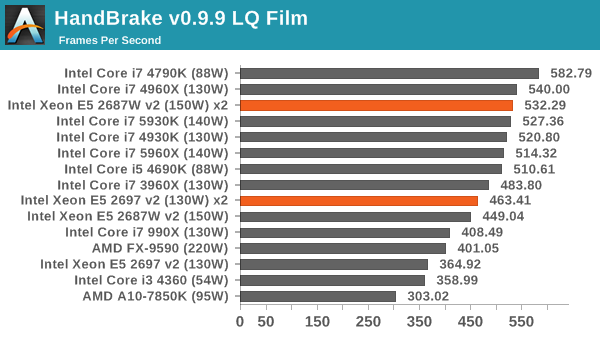
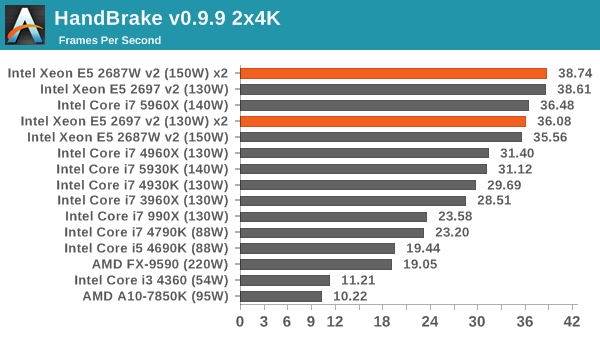
One would imagine that Handbrake could take advantage of all the extra cores on hand. For the LQ film, this is true at least for the faster frequency E5-2687W v2 model, however in 4K transcoding the data transfer between the CPUs becomes a bottleneck over raw CPU performance.
Rendering – PovRay 3.7: link
The Persistence of Vision RayTracer, or PovRay, is a freeware package for as the name suggests, ray tracing. It is a pure renderer, rather than modeling software, but the latest beta version contains a handy benchmark for stressing all processing threads on a platform. We have been using this test in motherboard reviews to test memory stability at various CPU speeds to good effect – if it passes the test, the IMC in the CPU is stable for a given CPU speed. As a CPU test, it runs for approximately 2-3 minutes on high end platforms.
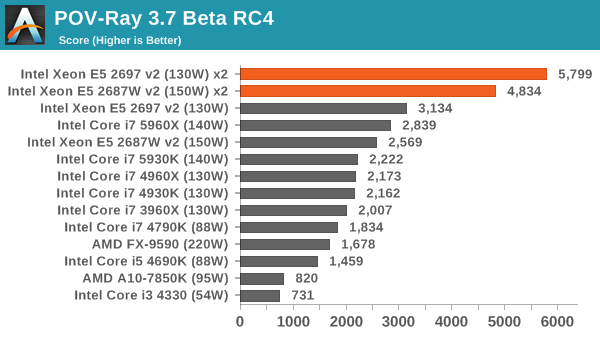
POV-Ray indicates more of what a 2P system should show: raw power. Here cores win out over frequency.
Synthetic – 7-Zip 9.2: link
As an open source compression tool, 7-Zip is a popular tool for making sets of files easier to handle and transfer. The software offers up its own benchmark, to which we report the result.
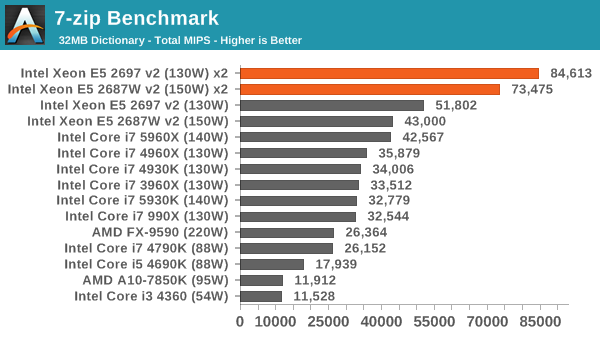










35 Comments
View All Comments
tuxRoller - Saturday, September 6, 2014 - link
I found a reference on serverfault that says windows ultimate 7 supports up to two sockets. How well it is supported is another matter...than anandtech seems uninterested in investigating.Kevin G - Sunday, September 7, 2014 - link
The scheduler is the same between Windows 7 Pro and Windows 2008R2. The difference is in the configuration defaults.The more defining factor between a single and dual socket system in Windows is how it handles NUMA. Modern chips all have their own memory controller and things get complicated when a thread running on one processor requests data off the memory in another socket. That'll cause a slow down due to the additional latencies involved. Ideally the scheduler will run a thread on the same socket as the memory it accesses but for large data sets, this isn't possible or practical to continually context switch were a thread runs. This is why having a system with the same clock speed, the same number of cores and the same amount of memory will generally be faster on a single socket than a dual.
Filiprino - Sunday, September 7, 2014 - link
What about pinning a game to a socket?You should get the same performance as the equivalent single socket CPU, same frequency.
Gonemad - Monday, September 8, 2014 - link
I believe the point of the reviewer was to prove this motherboard is worthless to gaming enthusiasts, that will get better bang for buck elsewhere.It could be a tremendous gaming platform back in the single-core day, as it was the case. I knew a couple of people that built gaming machines out of server parts exactly to get the benefits of a dual-core system, even when the applications were not built for it, but just forcing Windows to run on the 2nd chip, while the game would run on the 1st. At least, that was the consensus back then, however wrong that may be.
Today, it is proved to be a moot point, since you get more performance out of a single 8-core chip, with shared cache and optmizations, than relying on true dual-chip design to get your cores.
Applications that already relied on multiple cores just took a leap ahead, having so many of them to populate, which was evident on the compression software's benchs.
I believe that this whole benchmark is far from useless; it proves that this use case is totally incorrect for the purpose of gaming. On the other hand, the server platform is an excellent number cruncher, with the reliability to match it, but it can take some gaming on the side dish without effort. It won't take 'best bang for buck' lists by storm, but it won't force the buyer to build a machine just for gaming.
Arms9ForSoul - Tuesday, May 10, 2016 - link
As ohm's law becomes stagnant, and manufacturing size become's limited, it'd be nice to be able to buy a mainstream/performance mobo with multiple CPU sockets. This would also be an easy way to sell APU's since it would be cheaper and have "better" performance.